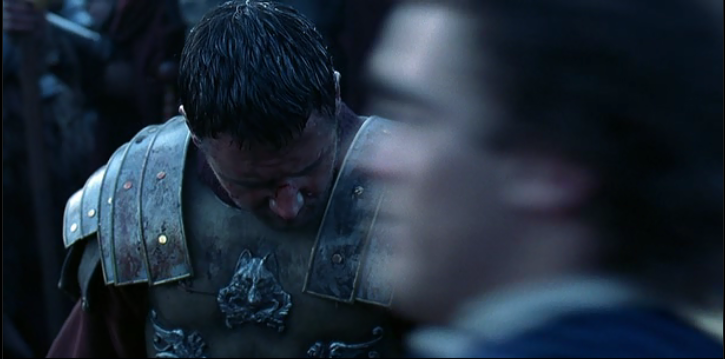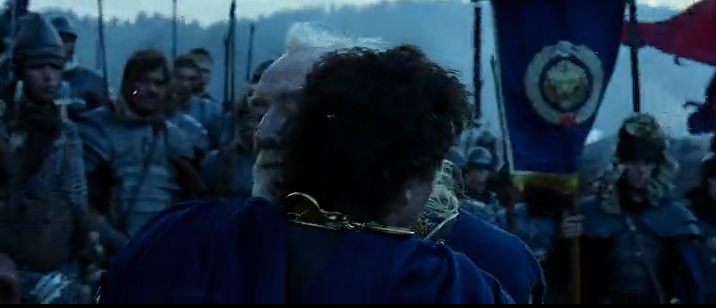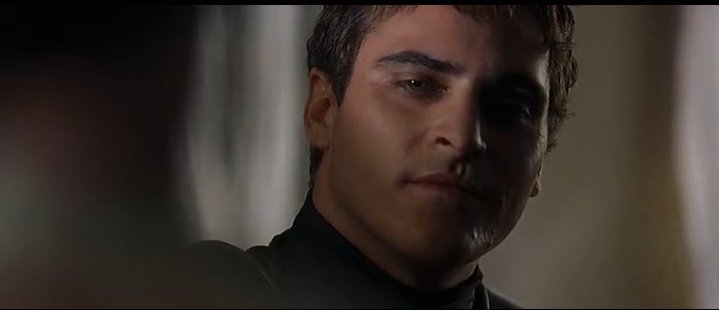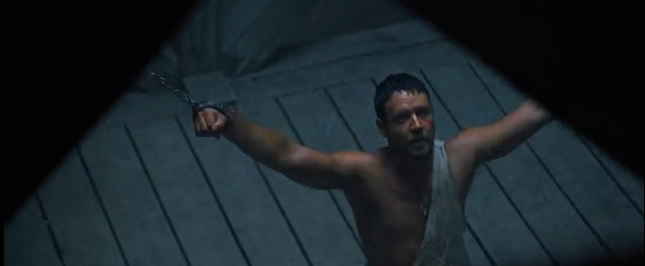Abstract
This paper promotes the idea that the 2000 film Gladiator is illustrative of what the classical approach to film-editing is all about, and elaborates on some of the technical aspects of how the director went about ensuring the high emotional appeal of the featured themes and motifs.
Gladiator: Classical Cinematography
One of the reasons why Ridley Scott’s 2000 historical drama-film Gladiator proved a huge commercial success is that the film’s editing style (classical) does correlate perfectly well with what appears to be the discursive significance of the featured plot. In my paper, I will explore the validity of this suggestion at length, while referring to the most notable indications of Gladiator indeed being a classically edited movie.
The film’s plot is not particularly hard to follow. While sensing that he will soon die due to old age, the Roman Emperor Marcus Aurelius (Richard Harris) decides in favour of General Maximus (Russell Crowe), as his successor to the throne. After having found out about this, the Emperor’s son Commodus (Joaquin Phoenix) kills Marcus Aurelius and orders the execution of Maximus – hence, making sure that nothing would stand on his way of becoming the Emperor himself. Maximus, nevertheless, manages to escape. After having nearly died, while trying to reach Spain (where he was born), Maximus ends up being turned into a slave.
Consequentially, he is forced to fight for his life as a gladiator. Within the matter of short time, he gains fame as a fighter who could not be defeated, which in turn deserves him a privilege to be introduced to Commodus – much to the sheer horror of the latter. Knowing that Maximus is very popular with citizens, Commodus decides not to kill him on the spot, and to wait for a better time to do this. Nevertheless, after having suppressed the Maximus-led uprising in the film’s sub-sequential parts, Commodus chooses to face Maximus in the Coliseum personally, in order to win the respect of the crowd. This proves to be a huge mistake, on Commodus’s part – despite the impossible odds, Maximus does manage to take revenge on his archenemy by the mean of driving a dagger through his throat.
As it was implied in the Introduction, Gladiator represents the example of the classical editing technique’s successful deployment, because the manner, in which the director went about connecting the film’s scenes together, corresponds to the foremost convention of this particular editing-style, “Classical theory insists upon the primacy of the original. It is that which must be imitated, and the basic and fundamental elements must not be changed” (Sobchack, 2012, p. 123).
This defines the main principle of the classical editing-technique in cinematography, “To keep the action logical and continuous, there must be no confusing breaks in an edited sequence” (Giannetti, 2001, p. 136). In its turn, this helps to explain why despite the fact that there are many prolonged time-lapses to the story of Maximus striving to restore justice – the story’s cinematic representation appears spatially plausible. The reason for this is quite apparent – in Gladiator, the subsequent shots are logically interconnected with each other, which was made possible by the director’s deployment of the ‘cut to continuity’ editing technique. To exemplify the validity of this suggestion, we can refer to the shot of Commodus walking towards Marcus Aurelius:
/ (00.16.26),
followed by the ‘bridging shot’ of this character passing Maximus:

(00.16.27),
which in turn is being followed by the rear-view shot of Commodus hugging his father:

(00.16.29).
The mentioned sequence of shots helps viewers to perceive the on-screen action, as such that is being thoroughly consistent with their intuitive understanding of how the flow of time affects the surrounding reality.
Another common feature of just about all classically edited movies is that the affiliated directors strive to emphasise the emotional intensity of the plot’s unravelling. As Giannetti noted, “Classical cutting involves editing for dramatic intensity and emotional emphasis rather than for purely physical reasons” (2001, p. 138). This is the reason why illumination plays a crucial role in this type of films – as practice indicates; it can serve as the effective instrument of allowing directors to ensure the psychological plausibility of the on-screen action. A particularly illustrative example of the legitimacy of this suggestion is the close-up of Commodus’s face, in the scene where he talks to his sister Lucilla (Connie Nielsen) while sounding rather ominously:

(02.16.05).
As it can be seen in the above-provided screenshot, the left side of Commodus’s face is shaded. This is being done, in order to encourage viewers to regard Commodus, as someone whose actions are being primarily reflective of his ‘dark side’ – quite despite the character’s self-assumed posture of a ‘benefactor of Rome’. It is understood, of course, that this provides even more psychological three-dimensionality to the character in question – hence, helping viewers to have a better understanding of what kind of person he used to be.
There is another notable quality to Gladiator, which validates the suggestion that it is indeed a classically edited movie – the fact that many of the film’s mise-en-scenes are concerned with connoting the implicit messages of their own. Apparently, while working on this particular film, Scott never ceased being aware of probably the main ‘mise-en-scenic’ rule of the classical editing-style – the camera-angle of a particular shot has a great effect on the audience’s perception of the idea that this shot supposedly conveys. In this respect, we can mention the shot where (in the aftermath of the upraising’s failure) Maximus is shown chained to the walls in a crucifixion-like manner:

(02.31.28).
It is concerned with providing viewers with the ‘bird’s-eye’ view on Maximus, with the character being visually shifted towards the bottom of the frame. Apparently, one’s exposure to this shot is expected to prompt him or her to contemplate the sheer magnitude of this character’s demise – in full accordance with Giannetti’s suggestion that “The areas near the bottom of the frame tend to suggest meanings… (of) subservience, vulnerability, and powerlessness” (2001, p. 52). There is more to it – being clearly reminiscent of the motif of crucifixion; this shot naturally causes viewers to draw parallels between Maximus and Jesus, which in turn contributes even further towards strengthening the overall dramatic appeal of the discussed movie.
In light of what has been mentioned earlier, it will be fully appropriate to suggest that the popularity of Gladiator with the viewing audiences cannot be debated outside of what appears to be this film’s editing philosophy. Apparently, while directing the production of this movie, Scott remained perfectly aware that it is specifically the classical editing-format, which suits drama-films more than any other.
The reason for this is that the commercial successfulness of these films directly depends on the director’s ability to ensure that viewers regard the affiliated twists of the plot fully plausible – something that is being made possible by prompting the audience to establish the emotional relationship with the featured characters. The main prerequisite of the latter is the cinematic exposure of these characters, like the existentially complex individuals, whose way of addressing life-challenges is being reflective of their ‘multiple dimensionalities’, as human beings. In this respect, the director’s application of the ‘cuts to continuity’ comes in particularly handy, because it helps to preserve the spatial integrity of cinematic action.
The same can be said about the role of properly designed mise-en-scenes in the classically edited film – they make it possible for viewers never to cease being emotionally drawn to what they see on the screen. This, of course, increases the aesthetic pleasure that people derive from watching such a film. Thus, it will be thoroughly logical, on our part, to suggest that the reason why, despite having been invented at the beginning of the 20th century, the methodology of classical film-editing continues to be widely used in modern films (such as Gladiator), is that it is consistent with the unconscious workings of one’s psyche.
It appears that the provided line of argumentation, in defence of the suggestion that Gladiator epitomises the classical approach to editing in cinematography, is fully consistent with the paper’s initial thesis. After all, as was shown earlier, Scott’s film is closely affiliated with the specifically classical editing-paradigm. Given the film’s subject matter, this state of affairs is best regarded as being thoroughly justified – the very epic sounding of the movie in question established the objective preconditions for the director to choose in favour of the classical methodology of film-editing. The fact that, in the aftermath of its release in 2000, Gladiator began to be increasingly referred to in terms of a ‘cult-movie’, suggests that Scott’s choice, in this respect, was indeed justified.
References
Giannetti, L. (2001). Understanding movies. Upper Saddle River: Prentice Hall. Web.
Sobchack, T. (2012). Genre film: A classical experience. In B. Grant (Ed.), Film genre reader IV (pp. 121-133). Austin: University of Texas Press. Web.
Wick, D. (Producer) & Scott, R. (Director). (2000). Gladiator [Motion picture]. Unites States: Universal Pictures. Web.